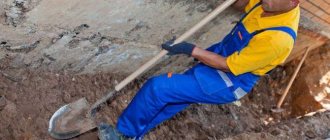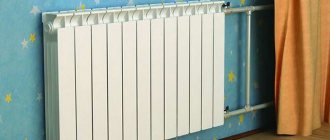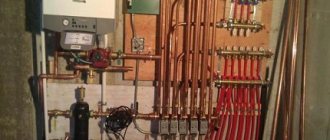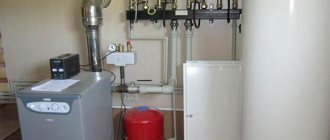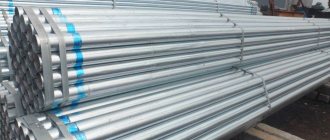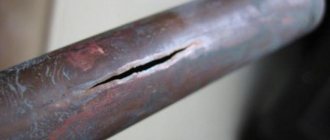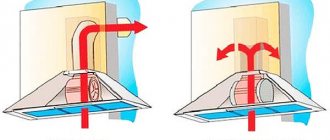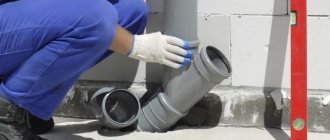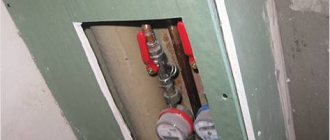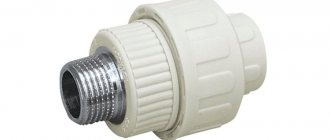Owning a home is the dream of many people. When the opportunity arises, they begin to build the mansion on their own. In the process of its construction, many questions arise. One of the most common is the laying of a sewer in a private house. If available, it provides comfort while living in the house. It allows you to drain wastewater from the dwelling into a special well.
When it comes to sewerage when building a house, many people turn to the services of specialists. Although their work is of high quality and after its completion, the owner receives an effective sewage system, nevertheless, their services are not cheap and require certain financial expenditures. Or maybe refuse outside help and do all the work on your own? Moreover, although there are difficult moments here, the task of an independent sewage system is not among the impossible. If you delve into the intricacies of constructing a sewer network in your home, then all the work can be done with your own hands, you can save a lot and get an effective sewage system.
What do you need to know?
When the owner decides to lay a sewer system in the house, then first of all it is necessary to find out if there is access to the centralized backbone... If such a line passes in your village, then the installation of a sewerage system in this case is not very difficult. You just need to find out from specialists:
- which pipes are best suited for draining wastewater and water from the house;
- how to lay pipes correctly;
- how to properly bring the pipes to the manifold.
The greatest difficulty when connecting to a centralized highway is laying pipes on the street. During this work, you have to dig a trench. How deep the trenches are required depends largely on the level of soil freezing. Usually pipes for sewage on the street laid at a depth of 0.5-1 m.
If your house is located far from the sewer main and there is no way to connect to it, then in this case you will have to start working on the device of an autonomous sewer system.
Installation features
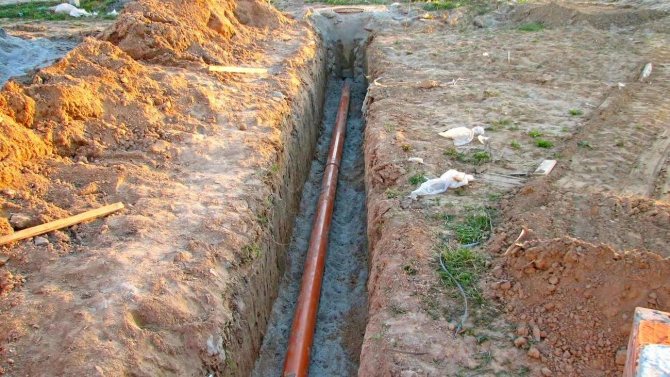
Pipes are laid below the freezing level of the soil with a slope towards the septic tank
External sewerage network laying technology:
- Preparation of the pit. The trench is dug with the calculation of such a position of the pipes, in which they would be 50 cm below the level of freezing of the soil (for the southern regions - 1.5-2 m, for the northern regions - 3-3.5 m). For pipes with a diameter of 110 mm, dig a trench 60 cm wide. The bottom of the ditch must be leveled and tamped. A layer of sand 10 cm high is formed on top.At the place where the pipe enters a septic tank or a collector, an area 2 m wide and 1 m long is created.
- Pipe laying. After completing the digging of the pit, pipes are laid along its length without cutting. Tees, crosses, revision fit into the required points. The assembly starts from a local septic tank. Before joining the pipe ends, lubricate with silicone sealant. If you need to create turns, it is better to use 45 degree corners. In these places it is worth installing a well with a revision.
- Warming. When installing an external sewage system, sometimes it is necessary to additionally protect the pipes from frost. If a trench is dug of sufficient depth, this is not necessary, but in regions with cold winters, it is worth playing it safe. Polystyrene, polyurethane foam, heat-insulating paint, basalt fiber or glass wool are used as insulation material.
- Backfilling.At this stage, it is imperative to use the soil that was selected from the trench. To prevent damage to the pipe, stones, hard clods and debris must be removed from the ground. It is better to use sand, at least to the level of the upper edge of the product. To compensate for the shrinkage of the earth above the trench, you need to make a small tubercle. If electrical equipment is installed in the sewage treatment plant, a screened cable must be laid in the ditch before backfilling.
You can complete each of these steps yourself. It is better to consult a specialist before work.
Types of sewerage in a private house
First, you need to decide how the sewer system will look like. It can have a different look:
- cesspool;
- septic tank.
Cesspool
Traditionally for the drainage of waste water from the home cesspools were used... Now they are considered a relic of the past. However, they have the right to life, if only because:
- they efficiently handle wastewater disposal;
- construction work is devoid of difficult moments.
If you decide to create a sewage system like a cesspool, then before embarking on the implementation of this idea, you need to learn about the engineering and geological features of the soil in your area.
The easiest option to build a cesspool is make brickwork... It is most reasonable to use red ceramic brick as a material. If you are ready to spend money on attracting special equipment, then you can arrange this structure from concrete rings. When constructing such a pit, the bottom is concreted, and then rings are installed. From above, the structure is covered with a plate with a ventilation hole and an inspection hatch.
Septic tank
In many homes, a septic tank is used as a sewerage system. Its main advantages are:
- simplicity of construction work;
- reliability during operation;
- the ability to install on your own;
- simplicity of work on the device of such a sewerage system.
At present there are several types of septic tanks... There are even three-chambered ones that have a high degree of waste and domestic water purification. And all due to the fact that such systems include a complex of aeration and biofilters.
Design and preparatory work
A project is a mandatory document required for a sewage system. It should be included in the plan of the house as a whole. If you have a ready-made version, adapted to a specific climatic zone, you can prepare tools, look for materials and get to work. If the project is created independently, it is better to show the result of planning to a specialist.
The device of external sewerage networks is carried out in accordance with the documentation that takes into account:
- the level of soil freezing;
- depth of groundwater - the installation site is chosen so that wastewater cannot enter the aquifers, fill the foundation or basement of the house;
- the possibility of access to the sewage treatment plant;
- septic tank volume - must correspond to the number of permanent residents, for 3 people a tank of 4 m3 is enough;
- location of inspection wells.
When creating an external drainage network, it is important to consider the location of the storm sewer.
Sequencing
Before starting work on the device of an autonomous sewage system in your home, you need to decide on a work plan:
First you need to decide where the cesspool will be located on your site. You should know that the drainage well must be below the level of the house.
It is also important to determine the place where the collector exits the structure. It is necessary to carefully inspect the place where the pipe exits, taking into account the fact that all waste water from your home will be concentrated at this point. It is necessary to inspect the place of admission in order to make sure in the correct installation of the collector... Distortions and deviations during installation must be absent.
When the site has been examined and important issues have been resolved, you can proceed to drawing up a sewage project.
It must be borne in mind that the external sewerage system must be straightforward. The inner one has many corners and bends, therefore, when working on its laying, all dimensions of pipes and bends should be calculated.
When all the important points have been resolved and all calculations have been completed, you can proceed to the acquisition of the necessary materials.
Next comes the turn for work on the installation of external and internal sewerage systems.
Choice of pipes
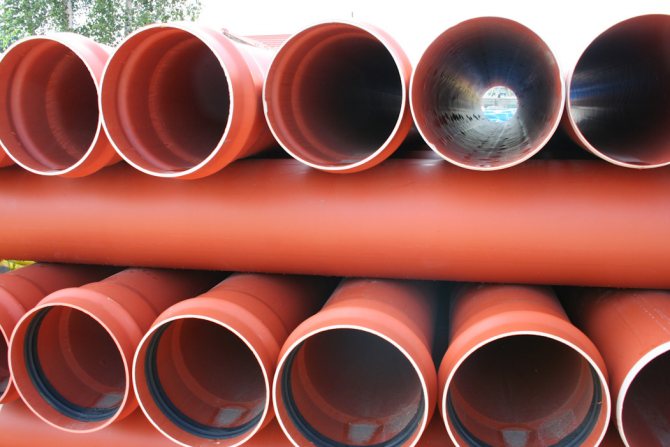

For outdoor sewerage, they produce red polymer pipes
Cast iron and asbestos cement are heavy, so it is difficult to lay sewage from such pipes on your own. Polyvinyl chloride, a lightweight, convenient and non-toxic material, is very popular when installing an internal drainage system. However, it is not suitable for the outer part - during severe frosts, the risk of cracking the walls increases.
Polypropylene has the following advantages:
- high resistance to low temperatures;
- chemical inertness;
- low weight of products;
- high mechanical strength;
- lack of corrosion;
- long service life;
- low roughness coefficient.
Polyethylene pipes have a significant advantage - they do not burst even with complete freezing. In addition, these products can withstand sewage temperatures up to 95 degrees and are resistant to aggressive chemicals. The service life of polyethylene products is 40 years or more.
Features of the choice of pipes:
- Polypropylene products should be smooth.
- When choosing polyethylene, it is better to purchase corrugated elements. They are better suited for the construction of an underground highway, since they cope well with high mechanical pressure (for example, if they are laid under an asphalt track).
Plastic products are easier to install, however, when choosing them, you need to take into account the operating conditions: the depth of the location, the presence of a passage area above the pipes.
Outdoor sewerage
The internal sewerage system does not differ in its appearance from that installed in the apartment. But the scope of work for its device will vary significantly.
The time and effort to create it will have to be spent less if the dwelling has old sewerage... In this case, the main work will be associated with the dismantling of old pipes. You can use old sewer pipes. However, it may turn out that you have to redo the entire system as a whole. In this case, it will take a lot of time and effort to create a new autonomous sewage system in the house. The floor will need to be raised.
And if it turns out that the depth of the sewerage is insufficient, then you will have to deepen it. To do this, you will have to dig a hole under the foundation, and then measure the distance from the bottom edge of the foundation to the top. It should be at least 1 m. In this case, the drains transported through the laid collector pipe will not freeze even in the harsh winter.
It is necessary to dig a trench from the outside of the house. directly to the well... It should be deeper than in the house. This is necessary to ensure a constant slope for the pipe. In this case, the drainage water will flow freely into the well.
At the exit from the house, the trench should have a depth of at least 1 meter, and every 10 meters the depth of the trench should decrease by half a meter.
The depth of the pipe exit from the house and the slope
Sewer pipes are laid at a certain slope. It has a certain, regulated value that determines the mode of movement of wastewater.If it is made too shallow, the fluids will move too slowly, which will cause sludge to settle and form blockages. At the same time, too rapid an exit of water will not be able to completely remove dense particles, which will also cause build-up and blockages. The proper slope of the sewage system has its own characteristics for pipes of different diameters:
- d = 50 mm - 30 mm per 1 m of length;
- d = 110 mm - 20 mm / m;
- d = 150 mm - 8 mm / m;
- d = 200 mm - 7 mm / m.
Please note that these values are recommended values, which are optimal only under the appropriate conditions. However, in any case, there is an upper limit on the slope value of 150 mm for each meter of pipeline length.
In details: Slope of sewer pipes according to SNiP
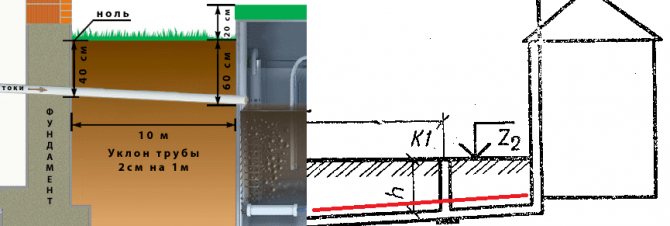

The drains are always laid on a slope
Since the point of entry into the cesspool or the first container of the septic tank is at a certain depth, and the pipes must be laid with a given slope, it is possible to calculate at what depth the pipeline should be taken out of the house. It is necessary to measure the length of the horizontal section of the outer part of the system and multiply this value by the recommended slope value. The result will show the difference in height between the points of entry into the septic tank and the release of pipes from the house. so that the depth of the sewer pipe does not turn out to be inconsistent with regulatory requirements, appropriate calculations should be made in advance. This is done at the stage of installing a septic tank. The well must be dug taking into account the slope, the specifics of the hydrogeology of the site and other factors of influence.
Laying sewer pipes in a trench
The construction of a wastewater drainage system involves laying pipes both outside the house and inside. Next, let's talk in detail about how the outer pipes should be laid. Experts in this regard give the following recommendations.
At the bottom of the dug trench, it is necessary pour a layer of ordinary sand... Its thickness should be 15-20 cm. The creation of such a sand cushion will protect the sewer pipes from excessive pressure, even if they are polypropylene pipes. Having laid the pipes on the sand, they will slightly shrink and take a comfortable position. This will eliminate the excessive load on them in the form of the pressure of the backfilled soil.
Another important point is the connection and sealing of joints. A tee must be inserted every 3 m of pipe. Thus, an audit will be equipped, which is the same pipe that goes to the surface of the earth. Revision is necessary so that in the event of a blockage in the pipe, it could be cleaned without any difficulties. Experts do not advise saving on the installation of an audit. The funds spent on the purchase of tees will pay off during the operation of the sewer system. After every four meters, preferably install revision... The outside of the pipe outlet is closed with a special plug.
Types of pipes used for installation
Depending on the temperature regime, the purpose of the pipes and their use, specialists, when installing the sewer pipes, pay attention to the material of manufacture and the diameter. The following pipe materials are now widely used:
- copper; - polypropylene; - metal; - sewn from polyethylene.
If the inlet pressure is low, then polypropylene, metal-reinforced plastic, XLPE can be used. For high pressures, it is recommended to use only copper pipes.
Internal sewerage
When installing an internal sewage system, many owners of private houses are increasingly using polypropylene pipes. These products have many advantages:
- they are not subject to corrosion;
- have a long service life;
- installation of such pipes is not difficult and affordable for every owner.
Having made a choice in favor of polypropylene pipes when laying an internal sewage system, it is necessary to take into account how many sources of wastewater are available in a private house. If a large number of plumbing fixtures are installed in the dwelling, then in this case it is optimal to use pipes with a diameter of 100 millimeters for laying the internal sewage system.
It should also be taken into account that when leaving the sink, the pipe must have a diameter of 50 mm... Therefore, during the laying of the internal sewage system, pipes of different diameters will have to be joined. However, note that at the moment this is not a big problem, since there are special adapters. Therefore, you can not worry about reliable sealing of joints.
When connecting the pipes to each other, it will be useful to check the quality of the gaskets. They should not be damaged, in this case, leakage at the joints will be excluded.
Risers are also equipped with an audit. Its installation is carried out from the floor at a height of at least one meter. In addition, special exhaust pipes are installed, which should be located above the roof at a distance of 70 cm... Why is such a complex riser design necessary? When a private house is connected to the sewage system, gases and unpleasant odors are inevitable. If the riser has reliable ventilation, then you can get rid of such unpleasant phenomena. Installation of a riser for ventilation of the sewage system ensures the displacement of polluted air. Therefore, spending time and money on its device, you can get rid of the unpleasant odor in your home.
Another important point to be aware of: if the riser is located in an unheated room, then it is necessary to carry out work on its insulation. A special release must be used to connect the riser to an external sewage system. Its diameter should be smaller than that of the pipe on the riser.
The installation of the outlet to the riser in the direction of the movement of polluted water should be carried out at an angle of 90 degrees. In addition, two 135 degree bends must be used to connect the risers. If there is a need for another additional riser, then use an oblique 45 degree tee... And besides this, an additional branch is installed.
It is much easier to arrange an autonomous sewage system in a household if there is one riser and one collector pipe. When laying an external sewage system, it is best to use 150 mm polypropylene pipes.
Selection of the installation site for the treatment plant
Laying sewage networks in an apartment with your own hands does not cause difficulties, it is much more difficult to assemble external networks. The laying of an external sewage system begins with the choice of the installation site of the treatment plant. Here are the basic requirements for choosing a septic tank installation site:
- The treatment plant must be removed at least five meters from the house. At the same time, it is also irrational to locate a septic tank far too far, as this will lead to lengthening of the external pipeline and an increase in the cost of its construction.
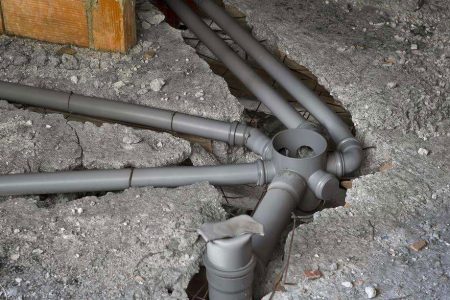

- Particular attention should be paid to ensuring that the septic tank is located as far as possible from the well from which drinking water enters the house. The minimum distance between these two objects is 30 m, and if the site has good filtering soil (sand), then this distance should be increased to 50 meters.
- The septic tank should not be located directly at the fence of the neighboring area; you need to step back from it at least two meters.
The use of sewer pipes for external sewerage: the price and features of the products
The choice of pipes for the installation of sewerage and water supply systems is based on various parameters, including safety, degree of strength and reliability, recommended operating conditions and cost.
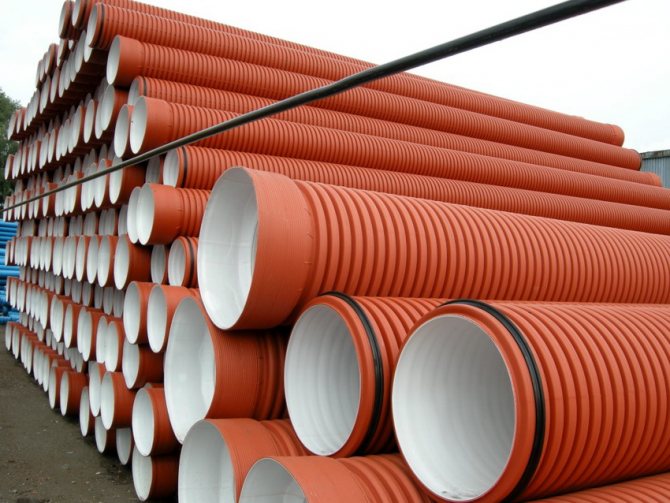

Double-layer PVC-U sewer pipes
The following types of products are used for plumbing:
- plastic pipes based on polymers (polypropylene, PVC, PVC-U, etc.);
- metal-plastic elements with thin-layer reinforcement using metal enclosed on both sides in a plastic sheath;
- metal pipes (copper, steel).
For products intended for the arrangement of sewage, similar requirements are put forward. In addition, pipes must be resistant to the influence of aggressive media.
The following types of products are used for sewerage:
- polymer-based plastic pipes (PVC);
- cast iron elements;
- ceramic pipes;
- products made of asbestos cement.
Polymer products perform well during operation, therefore, in most cases, these types of pipes are used for such work.
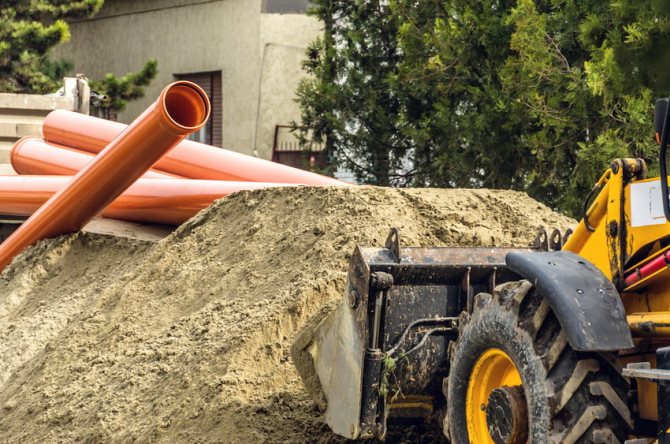

PVC and UPVC pipes are most commonly used in sewerage
Helpful advice! The plastic has low sound insulation. To ensure the comfort of operation, it is recommended to wrap the products in the process of installing the pipes of the external sewage system in noise-insulating material.
Features and prices of sewer pipes for external sewerage: PVC and PVC-U
PVC pipes are widely used for the organization of communication systems, as well as the restoration of existing highways. The products are suitable for moving any kind of waste. They are suitable as convenient and practical pipes for draining water from the roof and then transporting rainwater, as well as waste liquid from industrial and domestic facilities.
Advantages of PVC products:
- frost resistance;
- light weight;
- simple installation system;
- there is no need to use special equipment when working with pipes;
- resistance to corrosive effects;
- wear resistance.
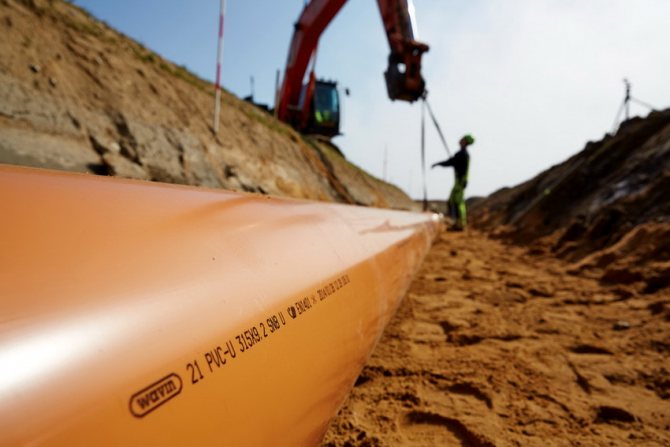

PVC pipes have proven themselves excellently in the operation of sewerage and water supply systems.
In households, the use of PVC-U pipes for external sewerage is widespread. Unlike PVC products, which can withstand temperatures up to 60 ° C, these elements are rated at 45 ° C.
Scope of PVC-U products:
- as a casing when forming wells (alternative to steel elements);
- for the arrangement of the storm sewer system and other utilities;
- piping systems for household and industrial use;
- for laying cables in block sewers as a protective sheath (flat and corrugated elements).
Average prices for PVC-U pipes SDR 41 PN6,3:
| Pipe length, m | Section size, mm | price, rub. |
| 6,1 | 90 | 525 |
| 6,12 | 110 | 770 |
| 6,14 | 160 | 1650 |
| 6,16 | 225 | 3170 |
| 6,19 | 315 | 6210 |
| 6,22 | 400 | 10270 |
| 6,26 | 500 | 16150 |
Prices for Korsis pipes for cable and household wastewater systems, rainwater treatment plants:
| Section size, mm | price, rub. (SN6) | price, rub. (SN8) |
| 110 | 170 | 180 |
| 160 | 300 | 320 |
| 200 | 410 | 430 |
| 250 | 625 | 660 |
| 315 | 950 | 1000 |
| 400 | 1480 | 1560 |
| 500 | 2250 | 2365 |
Note! The table shows the prices for Korsis pipes without a socket 1 m long.
Recommendations for the installation of cable ducts with your own hands
Cable duct is a system that serves to place electrical and telephone cables underground. The depth of the channels placement depends on the material of the pipes and can vary within the range of 0.4-2 m. Concrete pipes are laid the deepest. When working with plastic products, you can limit yourself to the minimum permissible parameter.
The optimal installation depth of the system also depends on the condition of the coating in the construction area. For pedestrian areas, you can take the minimum depth. If the system runs under a motorway or tramway, then the cable should be laid in the cable duct at maximum depth. To prevent the accumulation of water, add 4 mm per 1 m of the pipeline to the calculations for the slope of the communication.


To protect the cables, special pipes are used, most often PVC
There must be straight pipes in the sections between the wells. The maximum permissible deviation per 1 m of the pipeline is 1 cm. The diagram must include inspection chambers located at every 25 m of the pipeline. If the cable will be laid in collectors for disposal to the sewage treatment system or in the basement, you should abandon the use of pipes. In this case, consoles are used.
The standard size of the cross-section of pipes for the cable system is 15 cm, but it will be more rational to use products with a diameter of 10 cm. It is not recommended to put cables intended for different purposes in one pipe.
Recommendations for the installation of storm sewers in the country with their own hands
To correctly calculate and organize storm sewers, you need to take into account the following information:
- The average amount of precipitation recorded in the region by meteorologists.
- Frequency of rainfall and snow loads.
- The area of the territory for the collection of effluents.
- Chemical and physical parameters of the soil.
- Placement of all underground utilities.
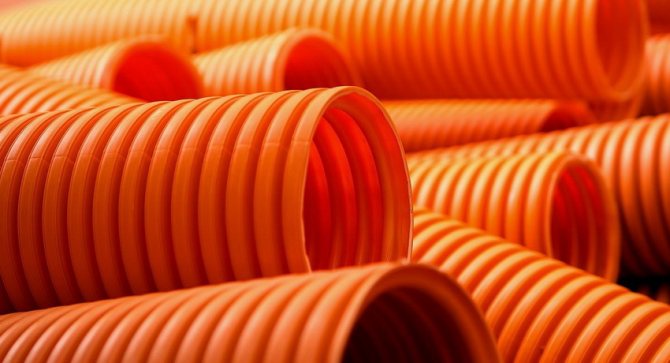

Corrugated PVC pipes for drainage system
At the first stage, a water collection gutter is equipped and drain pipes for the roof are installed. After that, you can organize a linear or point sewage system. On sale you can find all the elements for the construction of storm drains. In addition to standard parts, sand traps, siphons, plugs may be required.
The presence of storm, cable and domestic sewerage, as well as plumbing and heating systems is the key to the comfort of living in the house. There is only one way to avoid unpleasant consequences when installing these communications with your own hands - by choosing the right materials, and accurately performing the calculations.
Sewage ventilation system
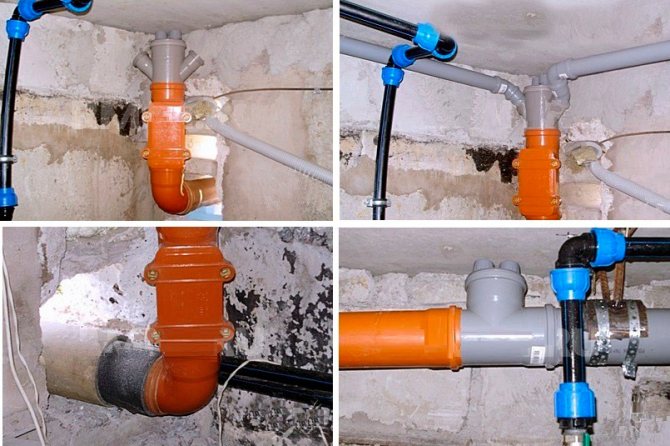

When installing an external sewage system, it is also worth taking care of ventilation, which will help ensure the following:
- Equalize pressure;
- Increase the flow of fresh air;
- Ensure silent operation of the sewage system;
- Eliminate unpleasant odors.
Many homeowners ignore this stage, which over time leads to unpleasant consequences, such as a decrease in the efficiency of the sewage system and the appearance of unpleasant odors. The solution in this situation is only one ventilation arrangement. By location, the ventilation system is of two types: internal and external.
For the arrangement of ventilation of the external sewage system, in most cases, a fan pipe is used, which serves as a continuation of the internal riser. It belongs to the internal sewerage system. For such a pipe to work effectively, it must be led out above the roof. It is worth considering the factor that it is necessary to place the fan pipe away from doorways and windows. In addition to the drain pipe, an air valve located on top of the riser is also used. Its installation is much simpler than a drain pipe and can be performed in an already built and functioning house. You can also make an air valve yourself using materials at hand. This rather simple design is able not only to block the movement of warm air, but also to protect water pipes from frost during the cold season.
How to avoid mistakes?
The following tips will help you to install the external sewage system quickly and efficiently, as well as avoid some basic mistakes:
- Show the preliminary draft to experienced professionals, listen to their comments and make the necessary changes.
- Do not skimp on materials - this difference in price is incomparable with the cost of repairs, which may be necessary if there are technological defects in the elements.
- Although this is not a mandatory requirement, think about insulating pipes with polystyrene or foamed polyethylene (you should not use mineral wool).This additional reinsurance will protect the sewer pipes from particularly severe weather and climatic conditions.
- Follow the popular wisdom "measure seven times, cut once" - carefully and accurately cut and adjust the pipeline sections, exactly observe the required slope angles, do not forget about the tightness control.
- Ask the seller about the composition and quality of the protective coatings for the inner surface of the septic tank. It is considered optimal to apply two layers of bitumen on top of the primer layer. If cast iron pipes are used, it is better to opt for products with resistant anti-corrosion coatings.
- Pay particular attention to the quality of the drainage pipes. In case of clogging or low throughput, water stagnation in the well is possible, which can lead to a number of unpleasant consequences.
But the main thing is to follow the safety rules, especially when using a dangerous tool or being near working special equipment.

